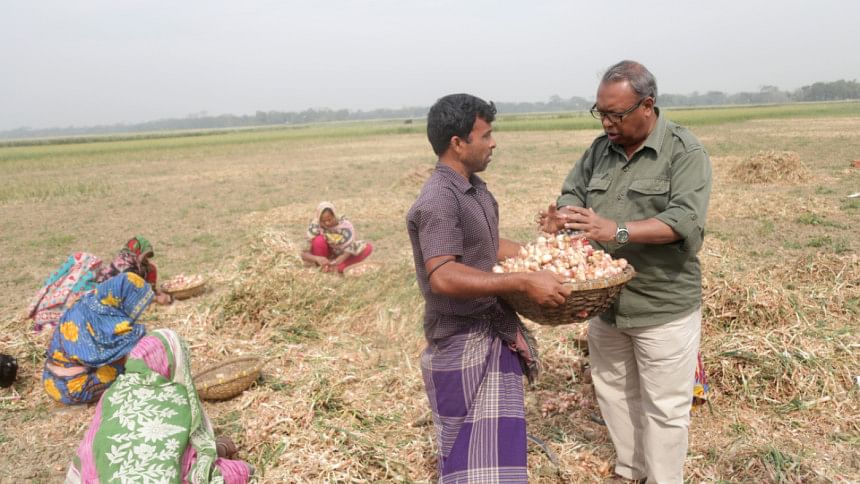Onions can bring back golden days

Couple of days ago, I noticed a troll on a social networking site. In the photo, someone found an onion and was giving it back to the owner of it. There was an outcry over the price hike of onion all over the country. Economic Crime Unit of Police's Crime Investigation Division has investigated the reason for onion's price hike. Report says, it didn't increase due to high price in the world market or domestic supply being low, the price increased because of a fake message. A section of dishonest businessmen created a pre-planned artificial crisis by stocking up onions, eventually bagging crores of taka.
In December, 2016, I went to Gazna Beel area of Pabna's Sujanagar. Over there, I saw onion being cultivated throughout vast fields. There was a bumper production. However, the farmers had a complaint. They were not getting the fair price. Even though they got plenty of production, they couldn't see the face of profit. Last year, farmers had a strong claim regarding onions in Hridoye Mati O Manush's field-level initiative, 'Krishi Budget, Krishoker Budget', that they were not getting the fair price for their onions.
Even in last year's December, the onion farmers of Gazna Beel were frustrated because of the low price they got. Flash flood and dense winter fog are two other reasons behind production fall that time, said Pabna's onion farmer Wahiduzzaman Rasel. As a result, instead of getting 40 maunds (one maund = 40 kg) per bigha, the production decreased to 25-30 maunds.
This year, during the second week of February, I went to Shariatpur's Naodoba. Onion is the golden crop of Naodoba. Locals claim that most of the country's onion production takes place here. According to the Department of Agricultural Extension (DAE), onions have been cultivated on 3,285 hectares of land in the area this year. In Zazira alone, farmers cultivated it on around 2,200 hectares of land. A large number of farm workers, both men and women, are passing a busy time harvesting the crop in the fields. Especially for the women farm workers, the season of harvesting onions is the season of earning. They are very much satisfied with their payment.
In Bangladesh, there is a yearly demand of 25 lakh tonnes of onions, of which, around 70% is produced locally and the rest is imported.
“When local onions go to the market, imported Indian onions start taking possession. Thus, the local farmers get low prices. The government could stop importing the crop considering the interest of the local farmers,” said Jasim Uddin, a farmer of Zazira.
Dear readers, the situation is almost all the same with other agricultural products. Farmers are being badly affected as they do not get fair price due to the imports during the peak season. That's when they send their products to market and eventually a clash between local and imported products leave them helpless. Although, at the start of the season, they were able to sell per kg of onion for Tk 70 to 80, currently they have to sell it for Tk 35 to 50.

To avoid the loss, the farmers have taken a different strategy. They are sending their produces to distant markets instead of their local ones to get a good price. They know now how the market works. Farmers are also growing different crops on the same field where they have onions. They're cultivating different spice crops, coriander leaves, and pumpkins. If they faced with loss with one crop, they cover it with another.
To be self-reliant through onion cultivation, we need to ensure three things: developing a variety which will be high-yielding and can be stored for a long time, ensuring facility for its preservation and making the market farmer-friendly.
Dear readers, the farmers have become very sincere to utilise the field to its maximum extent, and they are very interested to use modern and effective technology, from better seeds to machines to easy smartphone apps. Farmers now cultivate three to four crops a year. They expect a friendly market structure so that fair prices for the produces are ensured. Zazira's Borokandi market is the great example which completely is in favour of the farmers. However, for the farmers and businessmen to get fair price, it is necessary to determine market demand. An orderly market system can satisfy growers as well as consumers. In every region of the country, astounding crop-variation is seen on the fields. In that process, we will get diversified crops all through the year and with the fair market structure, farmers will be even more strengthened.

 For all latest news, follow The Daily Star's Google News channel.
For all latest news, follow The Daily Star's Google News channel. 



Comments